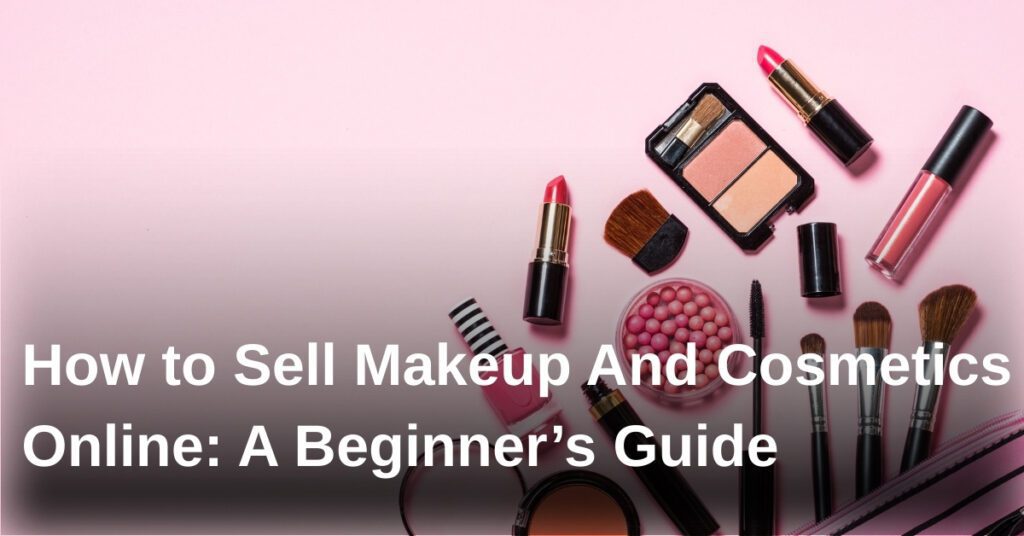
Diving into the world of online beauty retail can seem overwhelming, especially for newcomers. Yet, as more people look to the internet for their favourite products, the opportunity to sell makeup and cosmetics online has never been more accessible. Today’s digital landscape allows anyone to turn a passion for beauty into a thriving venture. In my opinion, understanding how to reach customers, present products effectively, and build trust is crucial to long-term success. This guide will walk you through the essentials, from choosing the right products to setting up your shop and attracting customers. Whether you’re exploring side hustles or starting a full-fledged business, learning to sell makeup and cosmetics online opens the door to exciting possibilities.
Main Points
To succeed in online beauty sales, you should focus on several important steps. First, research your market and select high-quality products that stand out. Next, set up a professional and user-friendly online store. Develop engaging product descriptions with clear photos to build customer trust. Additionally, use social media and digital marketing strategies to attract and retain buyers. Remember to comply with legal regulations for cosmetics, including labelling and safety standards. Finally, provide excellent customer service to encourage reviews and repeat purchases.
Understanding the Online Cosmetics Market: Trends and Opportunities
The fast-paced shift to digital shopping has notably transformed how brands Sell makeup and cosmetics today. Consumers’ expectations are evolving, often gravitating towards personalised recommendations and eco-friendly packaging. Interestingly, not all trends are universal; while some regions prefer organic formulas, others value innovative design more. For those looking to Sell makeup and cosmetics online, understanding these subtle regional preferences can unlock fresh business opportunities. Moreover, the online cosmetics market thrives on visual storytelling. High-quality product images, demonstration videos, and authentic customer reviews play a pivotal role in boosting engagement. Key trends to watch include:
- Virtual try-on tools: these help customers visualise products before buying.
- Influencer marketing: works especially well with niche audiences.
- Subscription boxes: offer convenience as well as variety.
However, success in this area rarely happens overnight. Continuous adaptation and creative digital strategies are essential for those aiming to Sell makeup and cosmetics in the fast-changing online landscape.
You Can Also Review These:
How to Start Selling Cosmetics Online: 6 Best Practices – GovDocFiling
Choosing Your Niche: Finding Profitable Makeup Products to Sell
Finding the right niche is crucial when you aim to Sell makeup and cosmetics. Instead of casting a wide net, consider focusing on a specific category—this could be vegan items, luxury brands, or inclusive shades. Consumer preferences often shift, but some trends, like cruelty-free or eco-friendly products, show enduring demand. Conduct market research to spot gaps and customer pain points; forums, reviews, and social media are invaluable here. Check competitors’ offerings and note what they might lack. Ideally, the products you choose to Sell makeup and cosmetics should have both a steady audience and reasonable profit margins. However, it’s not always easy to predict which items will consistently perform well. Factors like changing regulations or seasonal fads sometimes influence popularity. Nevertheless, relying on feedback and staying adaptable keeps you aligned with what buyers actually want when you Sell makeup and cosmetics online or in stores.
Sourcing High-Quality Makeup: Suppliers, Wholesalers, and Private Labels
Finding partners who sell makeup and cosmetics can be both exciting and slightly challenging, especially for those new to the industry. Reliable sell makeup and cosmetics suppliers offer a range of products, from well-known international brands to emerging indie lines. Nevertheless, it’s important to review minimum order quantities and sample policies, as these can differ considerably. Trusted wholesalers sometimes grant access to the latest trends earlier than mainstream channels, yet quality control may occasionally vary. When considering private labels with firms that sell makeup and cosmetics, you also open doors to custom formulations and branding. However, lead times and bulk requirements might surprise some businesses. Verifying certifications and ethical sourcing is crucial; after all, clients expect transparency. No single approach fits everyone, but investing time in research generally leads to thoughtful long-term partnerships. In this evolving market, a blend of intuition and investigation is often the best strategy.
Setting Up Your Online Store: Platforms and E-Commerce Solutions
Choosing the right platform to sell makeup and cosmetics online involves careful consideration of your business goals, technical know-how, and budget. There’s a range of e-commerce solutions, and each caters to different needs. Some prefer all-in-one platforms because they offer integrated marketing tools and inventory management, whereas others might lean towards open-source solutions for customization—although these can require a steeper learning curve. Popular choices often include hosted platforms with reliable support, but these may have certain transaction fees. Accordingly, some store owners balance between flexibility and simplicity. Below, you’ll find a quick comparison of well-known options to sell makeup and cosmetics products:
| Platform | Ease of Use | Features |
|---|---|---|
| Hosted | Very Easy | All-in-one, support |
| Open-Source | Moderate | Customization |
The best approach to sell makeup and cosmetics may depend on your product range and future plans. Therefore, take time to compare before settling in.
Crafting the Perfect Product Listings: SEO, Descriptions, and Photography
Optimising your online store to sell makeup and cosmetics effectively begins with sharp, well-organised product listings. Use strategic SEO by incorporating relevant keywords naturally into your titles and descriptions; this assists in boosting visibility, but overdoing it might come across as forced. Vivid descriptions do more than just inform—they encourage customers to imagine using each product. Aim for concise, benefit-driven sentences, especially when describing shades or textures that might otherwise seem ordinary. Photography plays a pivotal role as well. High-resolution images showing true colours and multiple angles can draw a hesitant buyer closer to making a decision. Nevertheless, perfect lighting and professional editing may not always be necessary; sometimes, authenticity in visuals speaks louder. When you list products designed to sell makeup and cosmetics, blend creativity with clarity. Accordingly, thoughtful listings build trust and increase the likelihood to sell makeup and cosmetics to discerning shoppers.
Developing a Brand Identity for Your Online Cosmetics Business
Crafting a unique brand identity is essential if you aim to sell makeup and cosmetics online. The journey begins by understanding who your ideal customer is and what values resonate most with them. While some buyers prefer bold and adventurous tones, others may lean towards a subtle, organic aesthetic. The logo, product packaging, and even your choice of website colors should collectively reflect what your business stands for—sometimes clarity emerges through trial and error. Consistency is key; use similar visuals and messages on social media, your website, and promotional materials.
“Your brand is what other people say about you when you’re not in the room.”
This truth applies, especially in beauty retail. Therefore, ensure that every interaction communicates reliability and a bit of personality. Eventually, these authentic touches help your cosmetics line stand out and gently nudge shoppers to sell makeup and cosmetics products.
Shipping, Packaging, and Handling Returns: Logistics for Beginners
Understanding the essentials of shipping, packaging, and handling returns is crucial when you set out to sell makeup and cosmetics online or in-store. Selecting the right packaging isn’t always clear-cut, as you must balance product safety with appealing presentation. It’s wise to consider factors like fragility, climate, and transit times. For makeup items, packaging that provides a snug fit and protection from moisture works best—still, preferences may vary.
- Packaging: ensures products arrive intact and presentable.
- Shipping: affects speed and customer satisfaction.
- Returns: require clear policies and streamlined processing.
Handling returns can sometimes be complex because each buyer’s reasoning might differ. Additionally, smooth logistics—not just for sending but also for receiving goods—enhance trust and repeat business. Therefore, focusing on these aspects supports a reliable reputation when you sell makeup and cosmetics.
Promoting Your Makeup Store: Social Media, Influencers, and Digital Marketing
Attracting new customers and retaining loyal ones often relies on how effectively you sell makeup and cosmetics through online channels. Leveraging social media platforms provides direct access to beauty enthusiasts and allows your brand’s personality to shine. By sharing tutorials, product launches, or customer reviews, you subtly influence shopping habits—even if the immediate impact can’t always be measured. Partnering with influencers may appear expensive at first glance, yet their sincere endorsements have the power to build genuine trust, especially in niche communities where credibility matters. You might notice that while digital marketing feels saturated, tailored content, like before-and-after makeovers or skincare tips, still captures attention. Sell makeup and cosmetics by combining engaging visuals with interactive stories, polls, and giveaways. Additionally, maintaining clear communication and updating your audience strengthens customer relationships. Therefore, it’s vital to experiment with different strategies until you identify what consistently drives results for your unique store.
Ensuring Legal Compliance: Regulations and Safety Standards for Cosmetics
Navigating the world of cosmetics requires a clear understanding of evolving regulations and safety standards. Every business aiming to sell makeup and cosmetics must comply with both national and, in some cases, international guidelines. This often involves proper ingredient labelling, safe packaging, and extensive product testing—even if the specifics might vary depending on the jurisdiction. Regulatory bodies usually require manufacturers to list all ingredients, but some elements are subjected to stricter scrutiny than others. In my opinion, staying updated with these shifting rules is crucial because authorities can and do investigate violations, sometimes without warning. Additionally, certain ingredients remain controversial, leading to ambiguous interpretations of what is “safe.” Therefore, to sell makeup and cosmetics legally and responsibly, ongoing diligence is key. Regularly reviewing changes and consulting with legal experts will help you avoid costly mistakes and protect your consumers.
Conclusion
Starting your journey to sell makeup and cosmetics online might feel overwhelming at first, but with the right steps, you can build a thriving business in this exciting industry. Remember, standing out comes from understanding your audience, showcasing quality products, and cultivating trust. Additionally, staying adaptable and authentic will help you grow beyond the competition. It takes commitment and effort, yet the rewards are absolutely worth it. In my opinion, with passion and smart strategy, anyone can successfully sell makeup and cosmetics online.
Related Articles:
How to Sell Audiobooks Online: A Beginner’s Guide
